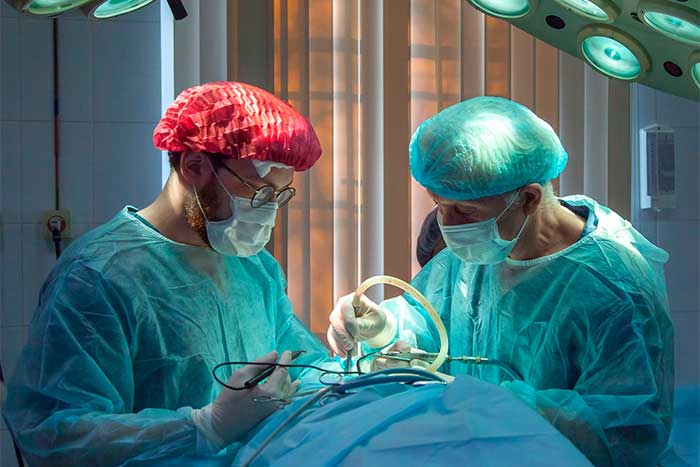Cardiothoracic surgery is a collective set of procedures addressing concerns of the thorax, or chest. A cardiothoracic surgeon may treat a wide range of concerns and diseases including pulmonary embolisms, heart failure, and cancers of the esophagus.


The specialty includes a number of procedures such as lung resection, vascular stenting, bypass surgeries, and many others. Coupling concerns of the heart and blood vessels with pulmonary ailments, cardiothoracic surgery diagnoses and treats problems with the heart, lungs, trachea, diaphragm, and esophagus.
A surgeon specializing in cardiothoracic procedures must first master general surgery before continuing their education to include at least two more years of fellowship training, the ultimate result is a certification by the American Board of Thoracic Surgeons. Cardiothoracic surgeries have been refined throughout the years and now include endoscopic surgeries, robotic procedures, and more invasive methods which require the chest to be open. The technology and techniques used in cardiothoracic treatment have evolved quickly to include state-of-the-art life-saving measures.
Renowned cardiothoracic surgeon, Lindita Coku is a proponent of technology that improves her patient’s quality of life. “The truest test of any advancement is its positive effect on a patient’s daily life,” says Dr. Coku. “As surgeons, we must continue to learn and discover best practices and procedures that, with the advancement of technology, can offer the safest, most successful outcomes for the patients in our care.”
In the past decade, medical advancements have continued exponentially, changing the landscape of cardiothoracic surgery and other areas of medicine with every passing day.
Robotics
Robotic technology was introduced in cardiothoracic surgery settings to provide precision in minimally invasive procedures. With more precision, the patient suffers less pain and is offered the possibility of a quicker recovery. From aortic valve replacements to coronary artery bypass, minimally invasive procedures are vast and provide a life-saving intervention with reduced trauma, smaller scars, and less blood loss. In Cath labs, robotic catheter navigation technology is nothing new, but the installation and use of this technology are still limited. As science advances and the benefits of remote-control execution become clear, technologies that were once considered a luxury are creating safer work environments and precise results.
Artificial Intelligence
AI is no longer the stuff of big-budget movies and sci-fi novels. In cardiothoracic medicine, it has become a hot topic in the form of machine learning—currently used in back-end elements of reporting and IT functions to streamline and enhance operations. As Artificial intelligence continues to improve, it has become vital in providing clearer, more accurate medical imaging. The automated ejection fraction calculations allow point-of-care ultrasounds to provide enhanced information. Some ultrasound systems now have the capability to identify, segment, and label anatomy and perform measurements through automation, giving precision to what was once a human-controlled function. As AI scoring and calculations increase, the margin for error or discrepancy is reduced, making analysis of images and interpretation more valuable to both diagnosis and treatment of cardiac concerns.
Virtual Reality Technology
Virtual reality, along with augmented reality, is now implemented in cardiology devices to improve training and offer enhanced views of cardiac events and disease. Simulators are a staple in large learning programs and have created new remote learning possibilities for cardiothoracic professionals. From simulated labs in virtual reality headsets to handheld probe simulators that mimic scanning with an actual ultrasound machine, the expanded opportunities for learning and exploring cardiac disease in three-dimensional renderings is a valuable training tool.
Transcatheter Mitral and Tricuspid Valve Interventions
Transcatheter aortic valve replacement (TAVR) is a newer technology that was only approved by the FDA in 2019 but has become the standard of care. As an alternative to surgical valve replacements, it’s predicted to be used in 75% of aortic valve replacement procedures by 2025. The new technology in working toward transcatheter mitral valve repair and replacements as well as transcatheter tricuspid valve repair and replacements are in FDA trials, and big names in the medical technology industry are looking to create a presence in this up-and-coming technology space.
Patient Monitoring Aids
With smartphones as a staple for most adults, offering patients wearable health-tracking devices is both prevalent and practical. Healthcare professionals have jumped on the general interest for these devices to help monitor patient health and provide life-improving interventions. From detection of high heart rates to abnormal sinus rhythm, the use of health-tracking is an easy, affordable, and accessible way for healthcare professionals and patients to keep their fingers on the pulse of personal health. Wearables are now common in remote patient monitoring and from consumer-grade to professional-grade, the tech is replacing or complementing the Holter monitors that once dominated cardiac care plans.
Structured Reports and Data Collection
Electronic medical records (EMRs) have transformed reporting for healthcare facilities. Along with helping communicate patient records, deliver results, and share patient information between organizations, EMRs have allowed for data mining and analytics to take center stage in all areas of medicine. Subspecialties are able to refine their workflows, monitor workloads, report procedure volume, and track the disease types and patient outcomes that define surgical success. With the click of a button, data is aggregated to provide a narrative that maps the successes and challenges of medical procedures and patient workflows. This newfound efficiency in patient management allows surgeons to focus on the highest and best use of their time—treating patients through surgical and non-invasive procedures.
The business of medicine requires an openness to technological advancement. In the years to come, the aging population will require medical professionals to put greater focus on cardiothoracic medicine and treatment options. With technology positively impacting patient care, quality of life, and healthcare workflows, the treatment outcomes for future generations look bright. Cardiothoracic surgeons must maintain a pace with the science to continue providing best-practice medicine as surgery methods evolve and improve.
